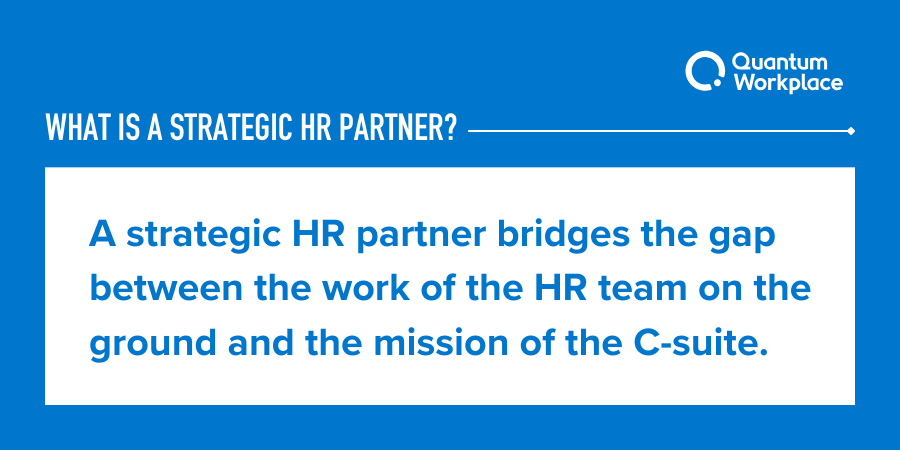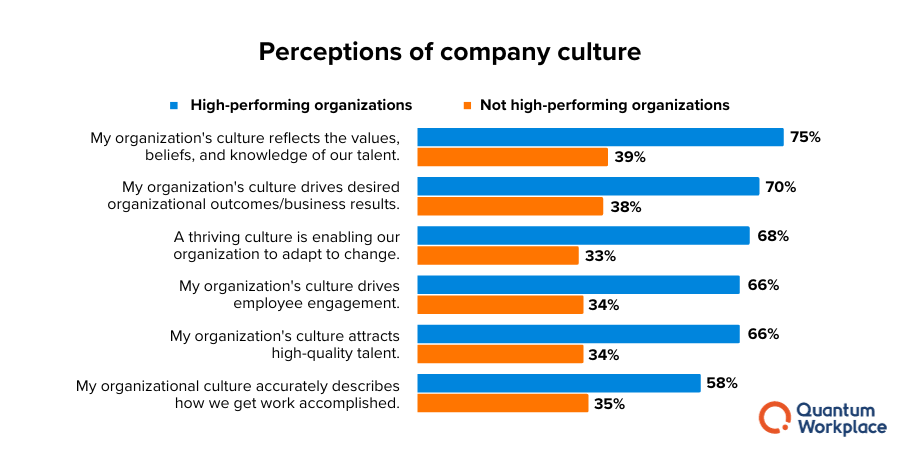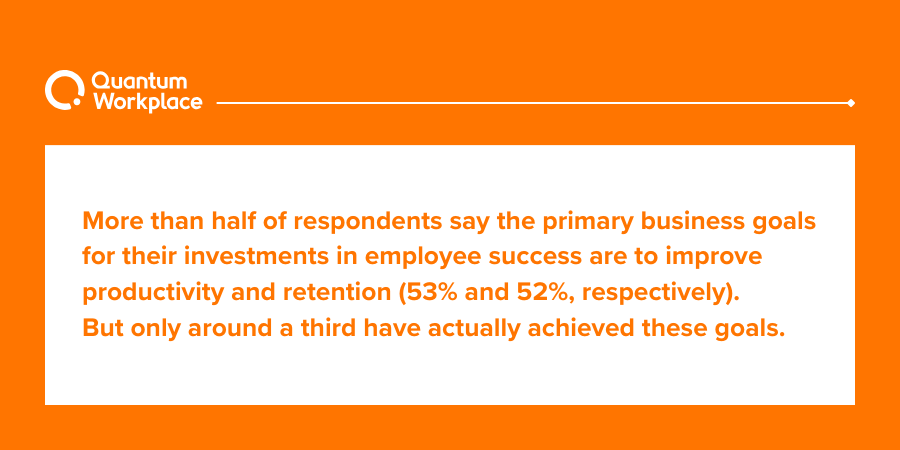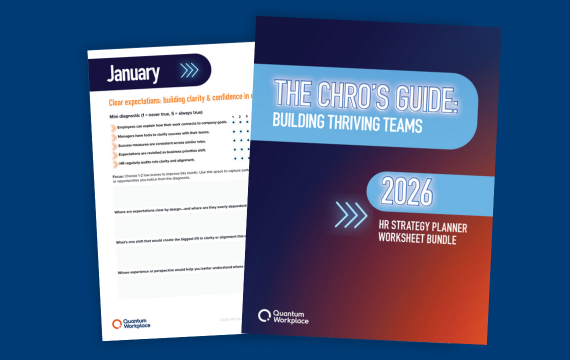Strategic HR in 2026: A Practical HR Strategic Plan to Build Thriving Teams
When HR departments operate in a silo—and their programs are disconnected and misaligned with the business’ strategic goals—it's a missed opportunity for both HR and senior leadership.
In fact, 70% of CEOs expect their CHRO to be a key player in enterprise strategy, but only 55% say their CHRO meets this expectation.
HR is uniquely positioned to influence the KPIs executives care about most—alignment, performance, retention, manager effectiveness, and culture strength—but only when strategy connects insight to action and equips managers to lead well.
The most reliable way to move the business forward is through thriving teams: teams that are aligned on what matters, empowered to act, growing in capability, and genuinely valued.
This article discusses how to build a 2026 HR strategic plan that delivers those conditions and sustains performance through change.
Get your free 2026 HR Strategy Planner: The CHRO's Guide to Building Thriving Teams >>
What is a strategic HR partner in 2026
A strategic HR partner isn’t just an HR professional who “thinks big.” It’s a leader who bridges strategy and execution—connecting the realities of teams with the direction of the business.
Strategic HR means:
- Translating business priorities into clear, aligned people strategies
- Equipping leaders to drive clarity, connection, and performance
- Creating the operating rhythms that bring strategy to life
- Using insights to remove friction, strengthen culture, and fuel results
In other words, a strategic HR partner closes the gap between what the business needs and how people actually experience work.
This shift requires moving from HR tactics (processing, administering, reacting) to HR strategy (aligning, enabling, anticipating).
It’s not about doing more. It’s about helping the organization, HR team, and people leaders across the business do what matters most.

The roles of a strategic HR partner
Instead of getting caught up in the minutiae of daily HR tasks, a strategic HR partner operates at a higher altitude, aligning HR initiatives with the overarching goals of the organization.
Strategic Advisor
Partners with executives to interpret business strategy and translate it into clear organizational priorities, talent needs, and people strategies.
Problem Solver
Identifies and addresses complex workforce challenges. Strategic HR partners are the go-to problem solvers in the organization.
Mentor and Coach
Invests time in nurturing talent within the HR team and helping managers become more effective leaders across the organization.
Alignment Driver
Ensures everyone within the organization is pulling in the same direction. Works closely with HR departments and the leadership team to align talent strategies with broader organizational goals, fostering a unified and purpose-driven workforce.
Why strategic HR matters more than ever
1. CEOs are refocusing on talent strategy.
Retention, leadership capability, and clarity across teams are business critical. Strategy means nothing without execution—and execution depends on people.
2. Culture is a performance driver.
Quantum Workplace research on organizational culture shows:
- 75% of high-performing organizations say their culture reflects their values
- 70% say their culture directly drives desired business results
Culture is no longer a “soft” concept—it’s a strategic lever.

3. Complexity is accelerating.
AI, shifting roles, and constant changes and reprioritization require HR to help teams adapt and align in real time.
4. Performance and engagement can't live in silos.
Performance without connection leads to burnout. Connection (engagement) without performance leads to drift. Both performance and connection are essential to building thriving teams.
5. Investments in talent strategy are underperforming.
Organizations have been investing heavily in productivity and retention—but only a third say those investments actually work. The gap isn’t effort. It’s execution. Leaders need clarity, capability, and support to act.

HR, as a strategic partner, can lead the way in reevaluating and redefining these investments to ensure they align with broader organizational objectives and drive the intended results.
6. HR impacts the bottom line more directly than ever.
Retention, alignment, productivity, and manager effectiveness all tie directly to financial outcomes. Strategic HR moves the business—not just people programs—forward.
A foundation for strategic HR in 2026
Quantum Workplace research show a clear insight: teams thrive when performance and connection (engagement) are both strong. And it's up to HR and people leaders to create the conditions for thriving teams.
Teams thrive when they have alignment, empowerment, growth, and a sense of feeling valued. Use these four conditions to help shape your 2026 strategic HR plan:
- Aligned: create clarity of purpose, priorities, and progress
- Empowered: give teams voice, trust, and tools to act
- Growing: develop teams in line with business needs
- Valued: make recognition, fairness, and retention daily focus areas
Your 2026 HR strategic plan (quarter by quarter)
Q1: Aligned
Create clarity and context at every level
Quantum Workplace research shows employees are 3.2x more likely to be engaged when their goals align with organizational priorities.
Quick Audit:
- Can employees name the top 3 company priorities right now?
- Do managers translate strategy into team goals and execution plans?
- Where do goals and feedback live—scattered systems or one connected source of truth?
Month 1: Building clarity & confidence in every role
Translate company priorities into plain language and define “what good looks like” for each role. Build two-way clarity through shared understanding of priorities, boundaries, and success signals. Add quick “clarity checks” to manager one-on-ones.
Month 2: Turning clarity into momentum with clear, aligned goals
Standardize your goal framework and treat goals as living roadmaps. Encourage co-creation and make progress visible in team meetings. Promote shared goals across interdependent teams to reduce silos.
Month 3: Keeping alignment alive through conversations
Strengthen alignment through short, frequent conversations focused on “what’s working, what’s changing, what’s next.” Keep purpose tied to progress in every touchpoint.
Dive into our 2026 HR Strategy Planner for more on this theme >>
Q2: Empowered
Giving teams voice, trust, and tools to take action
Quantum Workplace research shows engaged employees are 3.3x more likely to feel they have ownership and are involved in taking action.
Quick Audit:
- How quickly do survey insights reach managers in a usable format?
- Do managers know exactly what to do with the data?
- Where are decisions centralized that should move closer to the work?
Month 4: Turning employee feedback into clear insights
Translate insights into clear takeaways: “What we heard / What it means / What’s next.” Equip managers with focused reports and starter questions. Close the loop visibly with quick “you said, we did” updates.
Month 5: Removing barriers to performance
Use feedback to uncover systemic blockers like slow approvals or unclear ownership. Prioritize high-impact issues, run small “barrier sprints,” evaluate results, and scale what works.
Month 6: Building confident, insight-led managers
Provide structure—templates, frameworks, decision guides—not scripts. Connect engagement, performance, and development data to build context. Use nudges to make coaching and recognition effortless.
Dive into our 2026 HR Strategy Planner for more on this theme >>
Q3: Growing
Increase capability and build leaders across your organization
Quantum Workplace research shows employees are 2.3x more likely to stay when managers actively support their learning and development.
Quick Audit:
- Do growth conversations happen regularly or only at review time?
- Are development plans tied to future business capabilities?
- Are lateral moves and stretch work normalized?
Month 7: Making growth a daily practice
Elevate coaching as a core part of leadership. Provide prompts that make it simple (“What energized you this week?”). Recognize leaders who grow people—not just results.
Month 8: Turning reflection into action
Start with reflection, tie growth to business needs, and translate plans into stretch assignments, projects, and mentoring. Use the 70–20–10 lens to keep development practical.
Month 9: Developing for what's next
Publish role pathways and skill maps. Celebrate lateral moves. Use tools and AI to recommend development steps. Link capability building to future business priorities.
Dive into our 2026 HR Strategy Planner for more on this theme >>
Q4: Valued
Ensuring employees feel appreciated and valued
Quantum Workplace research shows the top three reasons employees leave are lack of career growth, lack of fair pay, and lack of recognition.
Quick Audit:
- Do employees feel seen for meaningful contributions?
- Are pay and promotion processes clear and trusted?
- Can you spot early retention risk before it becomes turnover?
Month 10: Making appreciations a daily habit
Tie recognition to values and measurable impact. Make appreciation timely and easy in the tools people already use. Encourage peer recognition and train managers to personalize it.
Month 11: Creating clarity in how work is rewarded
Create clarity in how work is rewarded. Separate performance and pay conversations but connect the data behind them. Equip managers with talk tracks and audit regularly for equity.
Month 12: Preventing turnover vs. reacting to turnover
Combine engagement, performance, and growth signals to spot risk. Focus on critical roles. Encourage stay conversations and act quickly to remove roadblocks or re-energize career paths.
Dive into our 2026 HR Strategy Planner for more on this theme >>
HR's role in 2026: architects of momentum
Strategic HR isn’t about owning every program. It’s about creating the conditions where managers lead well, teams thrive, and insight consistently turns into action.
Your greatest organizational impact comes from:
- translating strategy into clarity
- connecting priorities to daily execution
- helping leaders coach, align, and grow their teams
- simplifying complexity that slows momentum
- building rhythms that sustain performance
Done well, strategic HR becomes the engine of clarity, capability, and consistency across the organization.
Take the next step: build your 2026 HR plan
The 2026 CHRO Planner gives you everything you need to turn this blueprint into execution:
- Quarterly roadmaps
- Monthly worksheets
- Manager toolkits
- Reflection and alignment prompts
- Connected insight → action frameworks
Make 2026 your most strategic year yet. Get the 2026 Strategic HR planner!
Strategic HR FAQs
What is a strategic HR plan?
A strategic HR plan is a focused roadmap that connects people strategy to business strategy and gives managers the clarity and tools they need to execute consistently. It helps HR translate priorities, simplify decision-making, and use insights to guide action throughout the year.
How do I align HR goals with business strategy?
Start by deeply understanding organizational priorities, then translate them into role clarity, aligned goals, and simple frameworks managers can use with their teams. Alignment sticks when goals are co-created and reinforced through short, frequent conversations. Engagement and performance insights help confirm whether teams truly understand the strategy—or where more clarity is needed.
What conditions help teams thrive?
Teams thrive when they understand what matters, feel trusted to act, have opportunities to grow, and know their contributions are valued. These conditions strengthen both performance and connection and provide a practical structure for your 2026 HR plan.
How can I empower managers?
Empowerment comes from reducing friction—not adding steps. HR can support managers with simple frameworks, decision-ready insights, and lightweight tools that make alignment, coaching, and recognition easier. When expectations are clear and data is easy to act on, managers lead more effectively with less administrative burden.
How does the CHRO planner help HR executive more effectively?
The 2026 Strategic HR Planner provides a structured system for turning strategy into action—through quarterly priorities, monthly worksheets, and ready-to-use templates. It simplifies manager behaviors around setting expectations, reviewing goals, giving feedback, and recognizing impact, making leadership more consistent and scalable.
What should be included in a 2026 HR strategic plan?
A strong plan includes quarterly focus areas, monthly actions, and consistent leadership rhythms that build clarity, capability, and connection across teams. It should unify engagement, performance, and development insights into a single operating system—and equip managers with the tools and prompts needed to execute the plan consistently.





